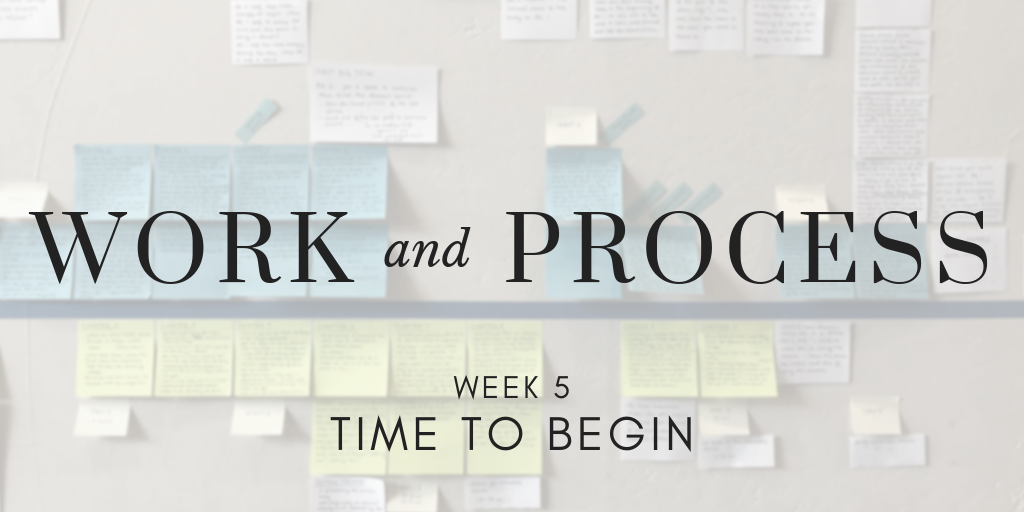|
Can we start today with one of my favorite poems, The Love Song of J. Alfred Prufrock by T.S. Eliot? (You can read it at The Poetry Foundation for a little lovely kick of language!) Among many other things, I love the sound of the words, how they’re strung together, their surprising harmonies, but what I’d really talk about today is what I think is the central question of the poem: How should I begin?
Prufrock starts with an invitation: “Let us go, then.” The speaker is ready to start his journey, but again and again, he hesitates, wonders, “Do I dare?” and “Do I dare?”, stops, thinks of all the inevitable conclusions to his journey, asks, again and again, how should I presume? and how should I begin? and, still, after all that (and it is a long poem), never actually begins. Sometimes, I feel like embarking on a new project can be like that. There is so much to do before you even write a word. I read. I research. I mull. I make playlists. I watch movies, TV shows, documentaries. I travel, if I can. I make notes. I build theogonies, magic systems, family trees. My friend Erin Summerill, who is perhaps the sweetest and most energetic person you’ll ever meet and also the author of the Clash of Kingdoms series, pre-writes. She recently mentioned to me that she had over 100 pages of pre-writing for a new project, absolutely putting me and my pitiful few spreadsheets and scattered notes to shame! So, with all of this research and note-taking and pre-writing to do before we ever actually make anything, how should we presume? And how should we begin? At what point do you stop studying 17th century ship battles or pause the YouTube videos on how to make a bow? When do you, unlike our dear immobile friend Prufrock, take the first step into your art? I imagine it’s different for everybody, but, in case it was helpful, I thought I’d share the two things I always need before I ever write the first words of a new project: the world and the beats. The World Although I’m not a thorough world-builder by nature, I do need to have some sense of the world of my book before I begin writing it. For me, that usually involves geography, time period (or for fantasy, analogous time period), technology (including magic, if it’s that type of story), values, some historical context, and the characters or various entities that will push or pull the story in one direction or another. When I started The Reader, for example, I had a map of the world (Kelanna), a rough technological mash-up from the 17th (ships) and 18th (guns) centuries, a magic system (Illumination), an illiterate society, and my main characters. In retrospect, I could and should have done more preliminary work on Kelanna, because as I went along, I discovered there were holes in my world, and I’d either have to stop writing to figure it out or just avoid the topic altogether. (How do Kelannans keep track of time? I still have no idea.) Many more masterful world-builders than me do this work ahead of time, and one of my goals as a writer is to develop more thorough world construction techniques. (I’m currently delving into The Planet Construction Kit, recommended by my friend, writer, and professional LARP designer, Ben “Books” Schwartz.) Because I only need the bare bones of a world before I start writing, I often start with just the bare bones, and that’s something I’d like to improve upon. The Beats Now, the one thing I absolutely have to have before beginning a new project and cannot for the life of me do without are the major story beats: the crisis points where the tension is highest or the characters have the most to lose, the turning points where the status quo changes so dramatically, it can never go back to the way it was before. (Some spoilers below.) When I started The Reader, for example, I knew:
That left a lot of story to cover in between, of course, a lot of dots to connect, but knowing these beats gave me goals to write toward and a sense of the characters’ arcs as well as the arc of the novel, and this, more than anything, is what I need to begin a project. While the world-building is certainly important and should not be dismissed, where my storytelling heart truly lies in structure. I am a structure writer. (Not to be confused with a plot or outline writer.) Structure is what excites me about a new project. Structure is what I fall in love with. I conceive of my novels by their direction, their contours and ridges, their silhouettes, their beams and bones. I understand my work by how it feels in my hands, by its framing, by what it’s going to look like against the horizon when it’s done, and that’s what drives me to take that first step into my art. To go. To dare. And disturb the universe. Next week: PLANTING THE SEEDS. For all I am a structure writer, I don’t naturally outline my projects before I begin them, and that’s because I’m also a discovery writer by nature. I love the feeling of knowing I’m writing toward something, but not knowing exactly how I’ll get there until I’m actually typing the words, until my characters are surprising me with where they want to go and what they want to say. Ever since learning this about me, my friend Meg RK has been asking how, if I don’t plot out every little bit of my novels, I can foreshadow so deeply the events to come. Well, I’m finally giving Meg her answer. Climb aboard the Foreshadowing Express with Meg and me next Sunday at tracichee.com and/or post your own responses with the hashtag #workandprocess. Write on. <3 Work and Process is a year-long journey of exploring and reflecting on the artistic process, craft, and working in a creative field. Each Sunday, I’ll post some thoughts, wonderings, explanations, and explorations on writing and creativity, and by the end of it, I hope to have 52 musings, examinations, meanderings, discoveries, bits of joy or inquisitiveness or knowledge to share. In each post, I’ll also include a topic for the following week, so if you happen to be inspired to question/wonder at/consider your own work and process, you’re welcome to join me. We’ll be using the #workandprocess hashtag across all social media platforms, and I hope we find each other to learn and connect and transform on our creative wanderings. Comments are closed.
|
ARCHIVES
February 2024
CATEGORIES |


 RSS Feed
RSS Feed